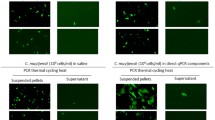Abstract
There are two approaches in detection of bacterium Erwinia amylovora by PCR. One is based on detection of plasmid pEA29 and the other is based on detection of a chromosomal DNA sequence, specific for E. amylovora, in a sample. Since pathogenic strains without pEA29 have been isolated from the environment, methods based on this plasmid have been compromised and PCR methods based on chromosomal DNA species specific sequences became only reliable methods. PCR method with chromosomal primers FER1-F and FER1-R is currently the most reliable method due to its high sensitivity and specificity. The goal of this research is to make a significant improvement of the method by optimization of PCR in application of hot start DNA Taq polymerase, instead of wax, to obtain a hot start reaction. This enzyme, which is currently widely applied, can provide simpler achievement of hot start, saving labor and time and decreasing possibility of cross contamination of samples. Experiments showed that simple replacement of a regular recombinant Taq DNA polymerase by a hot start Taq DNA polymerase leads to complete failure of the reaction. Many optimization experiments had to be carried out to obtain an operational and reliable PCR which simultaneously has high sensitivity and specificity. Content of the reaction mixture, as well as temperature and time parameters of PCR, were significantly changed to achieve proper optimization.
Similar content being viewed by others
References
Bereswill, S., Pahl, A., Bellemann, P., Zeller, W., Geider, K., Sensitive and Species-Specific Detection of Erwinia amylovora by Polymerase Chain Reaction Analysis, Appl. Environ. Microbiol., 1992, vol. 58, pp. 3522–3526.
McManus, P.S., Jones, A.L., Detection of Erwinia amylovora by Nested PCR and PCR-Dot-Blot and Reverse Blot Hybridizations, Phytopathology, 1995, vol. 85, pp. 618–623.
Llop, P., Donat, V., Rodrigez, M., Cabrefiga, J., Ruz, L., Palomo, J.L., Montesinos, E., Lopez, M.M., An Indigenous Virulent Strain of Erwinia amylovora Lacking the Ubiquitous Plasmid pEA29, Phytopathology, 2006, vol. 96, pp. 900–907.
Brown, E.W., Janisiewicz, W., van der Zwet, T., Preliminary Phenotypic and Genetic Differentiation of the Fire Blight Bacterium Erwinia amylovora, Acta Hortic., 1996, vol. 411, pp. 199–210.
Brennan, J.M., Doohan, F.M., Egan, D., Scanlan, H., Hayes, D., Characterization and Differentiation of Irish Erwinia amylovora Isolates, J. Phytopathol., 2002, vol. 150, pp. 414–422.
Maes, M., Garbeva, P., Crepel, C., Identification and Sensitive Endophytic Detection of the Fire Blight Pathogen Erwinia amylovora with 23S Ribosomal DNA Sequences and the Polymerase Chain Reaction, Plant pathol., 1996, vol. 45, pp. 1139–1149.
Guilford, P.J., Taylor, R.K., Clark, R.G., Hale, C.N., Foster, R.L.S., PCR-Based Techniques for the Detection of Erwinia amylovora, Acta Hortic., 1996, vol. 411, pp. 53–56.
Taylor, R.K., Guilford, P.J., Clark, R.G., Hale, C.N., Forster, R.L.S., Detection of Erwinia amylovora in Plant Material Using Novel Polymerase Chain Reaction (PCR) Primers, New Zealand J. Crop Horticultural Sci., 2001, vol. 29, pp. 35–43.
Bereswill, S., Bugert, P., Bruchmüller, I., Geider, K., Identification of the Fire Blight Pathogen, Erwinia amylovora, by PCR Assay with Chromosomal DNA, Appl. Environ. Microbiol., 1995, vol. 61, pp. 2636–2642.
Obradovic, D., Balaz, J., Kevresan, S., Detection of Erwinia amylovora by Novel Chromosomal Polymerase Chain Reaction Primers, Mikrobiologiya, 2007, vol. 76, no. 6, pp. 844–852 [Microbiology (Engl. Transl.), vol. 76, no. 6, pp. 748–756].
PCR Technology: Principles and Applications for DNA Amplification, Ed. Erlich, H.A. New York: Stockton Press, 1989.
PCR Protocols: A Guide to Methods and Applications, Eds. Innis, M.A., White, T.J., and Sninsky, J.J., San Diego, California: Academic Press, Inc., 1990.
Kreader, C.A., Relief of Amplification Inhibition in PCR with Bovine Serum Albumin or T4 Gene 32 Protein, Appl. Environ. Microbiol., 1996, vol. 62, pp. 1102–1106.
Nagai, M., Yoshida, A., Sato, N., Additive Effects of Bovine Serum Albumin, Dithiothreitol, and Glycerol on PCR, Biochem. Mol. Biol. Int., 1998, vol. 44, pp. 157–163.
Llop, P., Caruso, P., Cuberto, J., Moremte, C., Lopez, M.M., A Simple Extraction Procedure for Efficient Routine Detection of Pathogenic Bacteria in Plant Material by Polymerase Chain Reaction, J. Microbiol. Methods, 1999, vol. 37, pp. 23–31.
Author information
Authors and Affiliations
Corresponding author
Additional information
The article is published in the original.
Rights and permissions
About this article
Cite this article
Obradovic, D., Kevresan, S. Optimization of PCR in application of hot start Taq DNA polymerase for detection of Erwinia amylovora with primers FER1-F and FER1-R1. Microbiology 79, 816–821 (2010). https://doi.org/10.1134/S0026261710060147
Received:
Published:
Issue Date:
DOI: https://doi.org/10.1134/S0026261710060147




